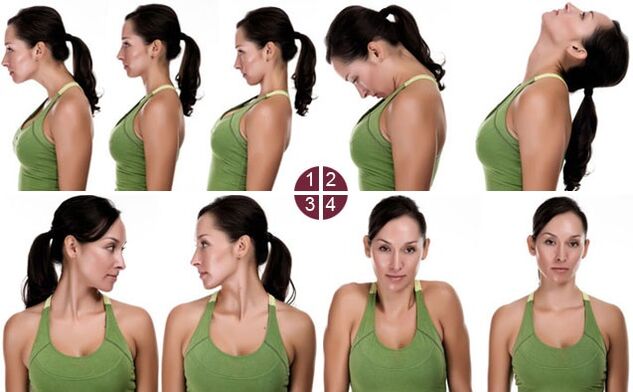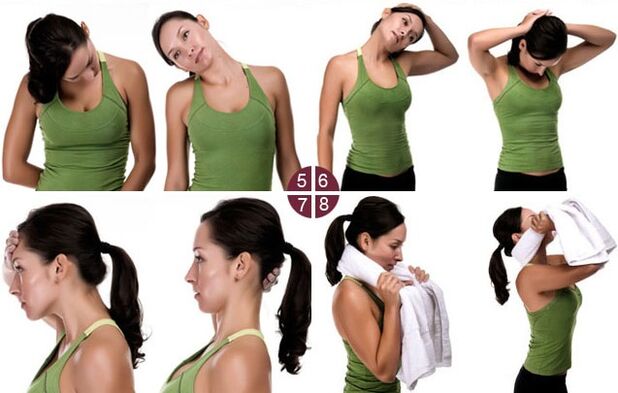
Osteochondrosis of the cervical spine is an insidious disease. The incidence threshold decreases every year, so the problem of treating cervical osteochondrosis is as acute as never before.
People who lead a sedentary and passive lifestyle eventually realize that osteochondrosis has quietly crept up on them.
The causes of osteochondrosis are the inactivity of the muscles of the back and neck, which weakens them. Spinal discs left without muscle support are heavily loaded.
A sedentary lifestyle and incorrect posture lead to deformation of the discs. Deformed vertebral discs pinch nerve endings. As a result, a person feels pain in the back, in the cervical spine.
How to treat cervical osteochondrosis and prevent its manifestation? Doctors recommend special exercises that strengthen the muscles and tendons of the neck, back and shoulder girdle. This is the safest way to treat osteochondrosis.
The benefits of exercise
As noted above, the causes of osteochondrosis are a sedentary lifestyle, weakening of the ligaments and curvature of the spine. In the early stages of the disease, exercise stops its further development. Thanks to regular physical activity, blood circulation improves, the muscles of the spine and neck region become toned, the load on the spine decreases, the distance between the intervertebral discs increases, the friction between the intervertebral discs decreases, and accordingly the frequency of pain decreases.


And if the disease has progressed to the point where they feel frequent severe pain, a specialist should be consulted. He establishes the exact diagnosis, the extent of the disease, prescribes the treatment and the massage. After completing the course, therapeutic exercises are prescribed, which you can do independently at home. Such treatment of cervical osteochondrosis at home will quickly allow you to forget about the disease.
Exercises must be selected correctly and performed in portions. Otherwise, there is a risk of health deterioration.
Useful tips
Before you start training, you should read the useful tips.
- A series of exercises must be performed regularly, regardless of location: study, work, home, etc. At first, to speed up your progress, do the exercises every day. And in the future, when the condition improves, you can practice 2-3 days a week to maintain the result;
- If you feel pain or swelling, it's time to get moving. In this case, you need to get up, walk, stretch, do exercises against osteochondrosis. You can walk a little;
- You must constantly complicate the lesson. You can add other exercises to the complex or increase the number of repetitions;
- Regular exercise is good, of course, but don't forget about your feelings. If during classes you feel severe pain in the neck region, you should stop classes;
- In order to increase the effectiveness of the treatment, you can go for a massage and take a contrast shower more often. These procedures contribute to further muscle relaxation;
- The exercises should be performed with a straight posture and attention should be paid to the execution technique. At first it will be a little difficult, but thanks to the correct execution, the muscles will get stronger and it will be easier to practice.
Exercise set (warm-up)
Before starting the exercises, be sure to start with a warm-up:
- You need to stand up straight, spread your legs shoulder width apart, take a deep breath and exhale several times. After that, you have to skilfully tilt to the right, left, forward, backward. Leaning back should be done carefully, without causing pain. If backbends cause pain, you can refuse to perform them.
- The next warm-up is turning the head to the right and left to the limit. Despite its simplicity, this exercise can cause difficulties for those whose cervical spine does not allow them to turn their head to the end in one direction or another. In such cases, it is not worth turning your head away. The exercise must be performed smoothly, without sudden movements.
- Finally, stand up straight, stretch your shoulders back, bring your shoulder blades together, lift your chest. Then reduce the shoulder joints, round the back. The exercise should be done slowly, smoothly, while inhaling and exhaling.
Types of exercises
This exercise tournament is not difficult. You can do them at home, standing or sitting. The most important thing is to keep your spine straight and your shoulders relaxed. But it is preferable to perform them while standing, since in this position the spine is straightened as much as possible.
Gymnastics #1
Press on the hands with the head forward. The hands should be clasped together in a lock and placed on the forehead. The hands locked in the lock push the head back, and the head must resist and push the hands forward. The neck should be tense. You should stay in this position for 15-20 seconds. Then place one hand on the back of your head and tilt your head back. At the same time, the working muscles of the neck are stretched. This exercise is useful for strengthening the muscles of the neck, which makes it possible to weaken cervical osteochondrosis.
Gymnastics #2
Manual pressure on the back of the head. In this exercise, you have to clasp your hands together in a lock and place them on the back of your head in this form. Then press the head with your hands and the head should resist the hands. Duration - 15-20 seconds. In this case, the muscles of the cervical spine become tense. This exercise can be combined with the first one for a harmonious workout.
Gymnastics #3
Head tilt to the side. In this exercise, place your right (left) palm over your ear. You should try to reach the right (left) shoulder with your head and resist with the working hand. Stay in this position for 15-20 seconds. Then do the same on the other side.
Gymnastics #4
Turning the head to the side. In this exercise, you have to turn your head to the side. To do this, place your right (left) palm on your right (left) cheek. Turn your head to the right (left) and the working hand resists. Each position should be held for 15-20 seconds.
Gymnastics #5
Stretching the neck by hand. Performing this exercise may be difficult at first, but you can get used to it with time. Place your thumb on the lower jaw and cover the back of the head with your other fingers. In this position, pull your head up, you can make swaying movements. That is, to simulate the attempt to pull the cork out of the bottle. You can't turn your head, you have to look straight ahead. The duration of the exercise is 15-20 seconds. The exercise must be repeated several times.
Gymnastics #6
Stand up straight and spread your arms out to the sides. Hands should be relaxed. Rotate the right and left shoulder joints alternately and then simultaneously. The body must be tilted forward. The exercise should be performed for 1 minute on each shoulder. This exercise is recommended for those who feel tension in the shoulder area.
Gymnastics №7
Head rolling. In this exercise, you need to turn your head towards the right (left) shoulder and stretch your neck. Perform head rolling to both sides. At the end of the repetition, the head must be turned to the other shoulder. Try to pull your shoulder blades back. Perform the exercise carefully, the movement of the head must be controlled throughout the exercise. In case of discomfort, you can simply turn your head to the side. The exercise must be repeated 10-12 times.
This is a complete complex of exercises aimed at preventing osteochondrosis of the cervical spine. It is not necessary to perform all exercises, you can only choose those that do not cause discomfort and pain. Office workers are advised to sit up straight while working. In addition, you can hang on the horizontal bar in the morning. This stretches the spine and gives momentum to the body. Swimming, figure skating, dancing, aerobics also help prevent the development of osteochondrosis and speed up the treatment process. If the classes are regular and the person himself becomes more mobile, then he can get rid of pain in the muscles and bones of the neck region.














































